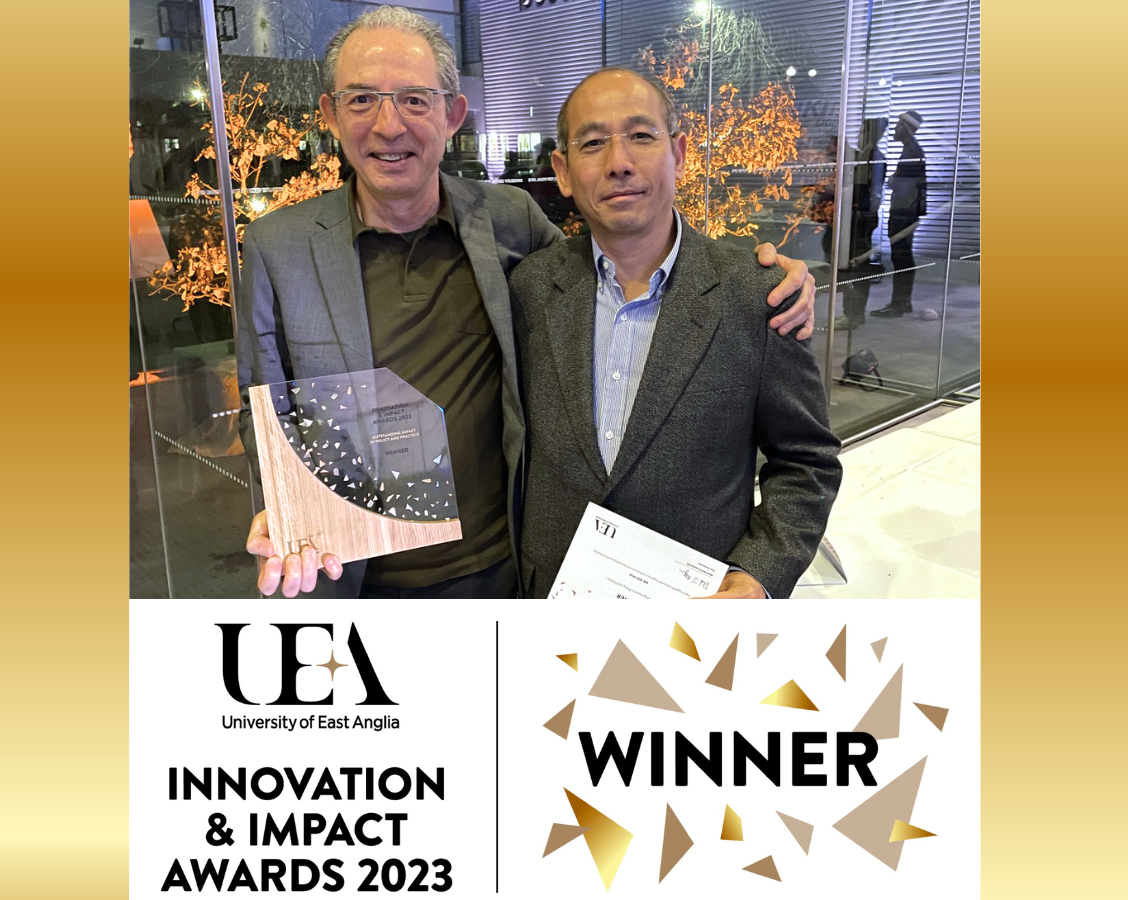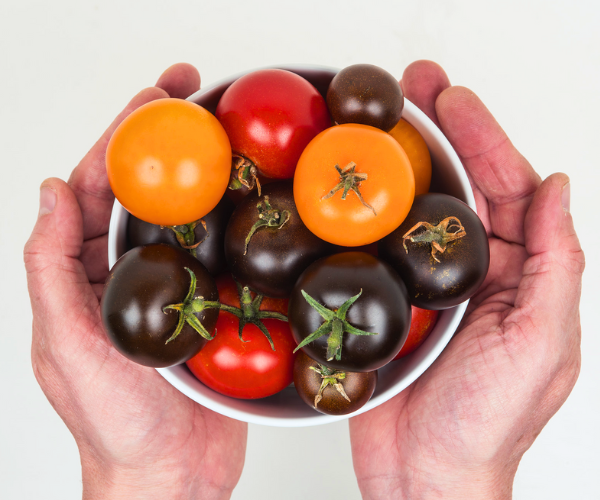Funding approved to develop new potato at The Sainsbury Laboratory
Research funding to develop a new potato which could be better for the environment, healthier for consumers and cheaper to produce has been approved.
The TSL Potato Partnership Project headed by Professor Jonathan Jones is set to receive £841,000 over five years from the Horticulture and Potato Initiative (HAPI) funded by the Biotechnology and Biological Sciences Research Council (BBSRC) and the Natural Environment Research Council (NERC). A further ten per cent will be provided by the industrial partners in the project: BioPotatoes UK Ltd and Simplot, based in the US. If the project is successful, both companies will invest in taking the potato through the process of regulatory approval and to market in the US and Europe.
The project, which takes a GM approach, aims to combine the benefits of ground-breaking research from TSL, The University of Leeds and Simplot in one Maris Piper potato that will be resistant to late potato blight and potato cyst nematodes. It will also contain much lower than normal levels of reducing sugars and asparagine – naturally occurring chemicals in many starchy foods that form acrylamide when cooked at high temperatures. In addition, by silencing a polyphenol oxidase, it will be less prone to bruise damage, which will reduce food waste caused by discarding bruised tubers.
Every year 120,000 hectares of UK land are devoted to growing this important staple food, but producers and processors face huge challenges getting potatoes to our plates.
- Late potato blight costs UK potato farmers an average of £55 million per year in losses and costs of controls.
- Potato cyst nematodes are increasingly hard to control. They cause up to £26 million a year in losses. Two out of five possible pesticides used to control them have already been withdrawn from use by the EU. The other three are under review by the EU and if they became unavailable, losses would increase to £55 million, leaving little or no control of this serious pest which can wipe out an entire crop.
- Bruising costs GB potato farmers £26 million each year and causes significant wastage in the supply chain and in the home.
 Professor Jones aims to begin work this autumn introducing three genes which confer resistance to late potato blight, two genes that confer resistance to nematodes and a further three genes which switch off the production of asparagine and reducing sugars and polyphenol oxidase, into a Maris Piper potato.
Professor Jones aims to begin work this autumn introducing three genes which confer resistance to late potato blight, two genes that confer resistance to nematodes and a further three genes which switch off the production of asparagine and reducing sugars and polyphenol oxidase, into a Maris Piper potato.
Professor Jones said:
“We’re still some years away from our final crop. It would need to go through all the necessary approval processes. If it passes those tests and if it is approved for planting, this potato could prevent many tonnes of pesticides and fungicides being sprayed on our land, increase yields and make a healthier crisp or chip.”
The TSL Potato Partnership Project is a public-private partnership. It combines scientific expertise from The Sainsbury Laboratory and the University of Leeds with commercial expertise from BioPotatoes UK Ltd, a small British company which aims to commercialise this technology in the UK to benefit UK farmers and consumers, and Simplot, a global agribusiness company that recently received US regulatory approval for its first generation Innate™ potato.

Project funders

Questions and Answers
Why do we need a potato with all these traits?
This potato will address three distinct factors which affect successful potato cultivation by UK and international growers. Substantial losses can be caused by nematode pests and by late blight disease, caused by a fungus-like organism which was responsible for the Irish potato famine.
Additionally, potato tubers are subject to bruising and deterioration during storage, causing elevated levels of naturally occurring reducing sugars and a substance called asparagine. Asparagine and reducing sugars when cooked at high temperatures - for example, frying or baking - cause the formation of acrylamide. Acrylamide is a chemical which occurs naturally in starchy foods when cooked at high temperatures and has been linked to cancer.
Eating a healthy balanced diet and minimising acrylamide formation in food, for example, by lightly toasting bread and frying chips to light golden colour is encouraged.
The European Food Safety Authority says that although studies on human subjects have provided limited and inconsistent evidence of increased risk of developing cancer from acrylamide in food, studies on laboratory animals have shown that exposure to acrylamide through diet greatly increased the likelihood of developing gene mutations and tumours in various organs. Based on these animal studies, EFSA’s experts agree with previous evaluations that acrylamide in food potentially increases the risk of developing cancer for consumers in all age groups, and that reducing exposure is desirable.
These challenges can be addressed, in part, by adding the right genes to the repertoire of genes that potatoes already carry.
Has the project been funded?
Yes. The Horticulture and Potato Initiative has now announced the funding. The project is due to start in the autumn.
Who are your partners on the project and what will each of them contribute?
The project comprises a partnership between TSL, University of Leeds, Simplot and BioPotatoes UK Ltd. The industrial partners will between them contribute 10% towards the costs of the project. TSL will contribute expertise in blight resistance and Leeds will contribute expertise in potato cyst nematodes. Simplot will contribute its expertise in tuber quality improvement and share relevant technologies to help the project deliver its aims.
How much will the project cost?
This project will cost approximately £900k over five years.
How many genes are you putting into the potato and how will they work?
The aim is to put in three different genes for potato late blight resistance, and two genes that confer enhanced tolerance of PCN. We will also put in two genes that between them silence (specifically in the tuber) three different genes (for polyphenol oxidase, invertase, and asparagine synthetase). We will also use a gene from tomato to help us select for potato cells, tissue and plants that have received the intended genes in the laboratory.
Aren’t there already blight resistant potato varieties available?
Potato varieties have been bred with late blight resistance, but these do not find widespread favour in the current market, and may also be susceptible to nematodes. When farmers choose which potato variety to plant, and when processors or supermarkets choose which varieties to source, they take many different factors into account, not just blight resistance. The main varieties favoured by the market, such as Maris Piper in the UK and Agria in the rest of Europe, are potatoes that meet market requirements. The approach in this project is to use the GM method to introduce genes that will improve already-popular varieties. A different and perfectly reasonable approach taken by others is to try to breed new blight resistant varieties that meet market requirements. There is no reason why these approaches cannot co-exist.
Can you describe the different stages of the project before the potato is available?
First, scientists have to construct the combinations of DNA sequences that will be introduced into plant cells of the variety Maris Piper.
They will then have to conduct the gene introduction, and select plantlets that carry the introduced genes.
They will examine many independent lines to see whether each has received the DNA of interest, and confirm whether those which have received a single copy of each gene of interest, are expressing the genes appropriately in those lines.
Once such lines have been identified in the lab, they will be ready to test in the field to ensure they retain all the characteristics that make Maris Piper a favoured variety.
When a suitable line has been identified during field trials, scientists will start to accumulate data that can used to prepare a dossier for submission to the independent regulatory authorities to show the new variety is productive, has the intended additional properties and no other(s), and is safe for human consumption. This will probably require additional funding and be undertaken starting at the earliest 3 years after the beginning of the project.
You have already developed a potato with resistance to late blight using a resistance gene. Does this single gene no longer work?
Absolutely not. The first gene cloned is extremely useful, and we wish to use it wisely to retain its usefulness as long as possible; this requires that it only be commercially deployed in combination with additional resistance genes. Like antibiotics, if one relies entirely on only one mode of action, the pathogen can evolve to evade that action. Therefore, if one can deploy multiple resistance genes with multiple modes of action at the same time, evolution of the pathogen to simultaneously overcome these multiple modes of action will be slower, and so the durability of each mode of action is safeguarded.
How long will it be before these potatoes are available?
Realistically, 8-10 years at the earliest.
What is the potential return on tax-payers’ money?
The effect of the Irish potato famine shows how serious potato diseases are for food security. We will need new, safe, disease-resistant and pest-resistant crops if we are to feed an increasing global population and to support the farming industry. Food and farming in the UK is a major manufacturing sector and the largest employer; potatoes are a key part of that industry. Furthermore, European regulations have led to tighter restrictions on use of agrochemicals, which increase the urgency for alternative solutions.
Late potato blight costs UK potato farmers an average of £55 million per year in losses and costs of controls. Potato cyst nematodes are increasingly hard to control. They cause up to £26 million a year in losses. Two out of five possible pesticides used to control them have already been withdrawn from use by the EU. The other three are under review by the EU and if they became unavailable, losses would increase to £55 million, leaving little or no control of this serious pest which can wipe out an entire crop. Bruising costs GB potato farmers £26 million each year and causes significant wastage in the supply chain and in the home.
The previous funded work has revealed great insights into blight resistance, has developed new technologies to accelerate cloning of resistance genes, and has trained some outstanding early-career researchers. Many of these advances will benefit the wider bio-economy and not just the UK potato industry. Furthermore, this has added to the control options available which support integrated pest management and provide the potential to safeguard the effectiveness of existing control measures such as fungicides used to control late blight. This project will enable us to bring the results of these discoveries to market.
How will the potato benefit the environment?
The carbon footprint of potatoes in the UK today includes the extensive use of agrichemicals to control blight and nematodes, and emissions from regular tractor use. This project will enable reductions in both. Furthermore, the project will reduce food waste that arises when tubers are discarded or rejected in the supply chain or at home.
How is the potato good for consumer health?
Potatoes are an important source of fibre, carbohydrates, vitamins and nutrients in our diet.
When baked or fried at high temperatures, potatoes, like other starchy foods can form acrylamide. This is not a new element in the diet; humans have probably been exposed to acrylamide in small doses since they first started cooking starchy foods.
The European Food Safety Authority says that although studies on human subjects have provided limited and inconsistent evidence of increased risk of developing cancer from acrylamide in food, studies on laboratory animals have shown that exposure to acrylamide through the diet greatly increased the likelihood of developing gene mutations and tumours in various organs. Based on these animal studies, EFSA’s experts agree with previous evaluations that acrylamide in food potentially increases the risk of developing cancer for consumers in all age groups.
Eating a healthy balanced diet and minimising acrylamide formation in food, for example, lightly toasting bread and frying chips until they are a light golden colour is encouraged.
Simplot’s Innate (TM) technology, which will be used in the development of the new potato at TSL, could reduce acrylamide formation in that potato, when cooked at high temperatures, by up to 90%.
Will the potato be safe to eat?
Yes. Many of the aspects of this technology exist in other edible crops. There is no reason to anticipate it might be unsafe to eat, but to ensure this, extensive food safety testing will be undertaken before it will permitted to be brought to market.
Is the GM technology that is being used safe to use in developing food for human consumption?
Many independent studies and reports have come to the conclusion that GM food is as safe as conventionally produced food.
How will the potato reduce wastage?
The project will reduce food waste that arises when tubers are discarded or rejected due to bruising or too high levels of reducing sugars and free asparagine. This will increase the number of potatoes reaching consumers and should thus have the benefit of making more food available from the same land and reduce the overall cost of food production.
Will you be holding field trials of the potato, and if so, where and when?
We will conduct field trials in Norwich in a confined area protected by a secure fence which has been used before for trials of this type. The earliest time when we might begin trials is Spring 2016. The trials will continue for five years. If the work succeeds in producing a potato line that carries all the desired and intended characteristics, and no adverse side effects, further funding will be sought to generate data to make the case for submission to regulatory authorities for commercialisation.
How will you make sure that your potato plants don’t cross-pollinate with other plants in the environment?
Because potatoes are propagated as tubers, their seed is never a source of cultivated potato plants. During the field trial phase, they will not be grown near any other potatoes.
Is there a risk of gene transfer to other plants during field trials and if the plants are commercially grown?
Because potatoes are propagated as tubers, their seed is never a source of cultivated potato plants. During the field trial phase, they will not be grown near any other potatoes. Trials have to go through numerous regulatory checks at an UK and EU level and this is one of the factors taken into consideration before commercial crops are licenced.
How do you know the trial will be safe?
Rigorous regulations govern the planting of GM crops in the UK. The Government's independent group, ACRE (the Advisory Committee on Releases to the Environment), will be assessing the application for permission to conduct the trial.


